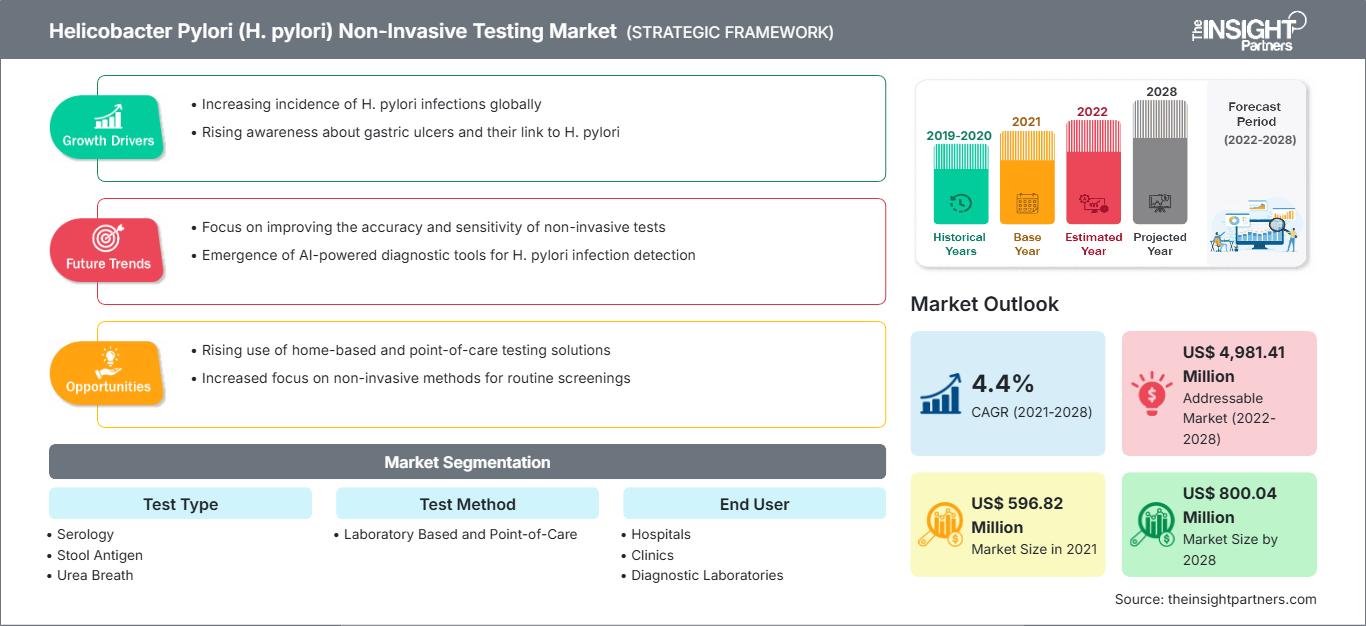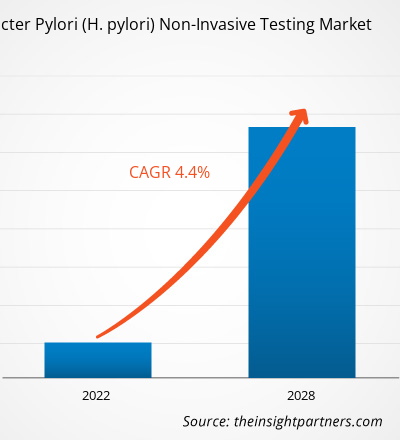Le marché des tests non invasifs pour Helicobacter Pylori (H. pylori) devrait passer de 596,82 millions de dollars américains en 2021 à 800,04 millions de dollars américains d'ici 2028 ; sa croissance devrait atteindre un TCAC de 4,4 % entre 2022 et 2028.
La prévalence croissante de l'infection à H. pylori et les avancées technologiques stimulent la croissance globale du marché. De plus, les stratégies mises en œuvre par les principaux acteurs offrent des opportunités lucratives sur le marché mondial.
Helicobacter Pylori (HP) est un facteur majeur responsable de l'ulcère gastroduodénal et de la gastrite. Selon le rapport de la Public Library of Science (PLOS), environ un tiers des adultes d'Europe du Nord et d'Amérique du Nord sont infectés par HP, avec une prévalence très élevée en Afrique, en Amérique du Sud et en Amérique latine. L'Amérique centrale, l'Asie et l'Europe du Sud et de l'Est représentent 50 %. De plus, l'infection à H. pylori est élevée chez les adultes, avec quelques variations géographiques. Par exemple, le rapport du National Institute of Health (NIH) indique que l'infection à H. pylori chez les adolescents est de 30 à 50 %, et chez les adultes, elle atteint 90 % dans les pays en développement.
Le rapport de la Clinical and Experimental Pediatrics (CEP) indique que la prévalence de l'infection à H. pylori a diminué. Bien que le taux d'infection à H. pylori ait diminué en Corée du Sud et dans les pays développés, 33 % des enfants asymptomatiques ou en bonne santé sont toujours infectés sérologiquement dans le monde, selon le même rapport. Par exemple, des pays développés comme le Japon, l'Allemagne, les Pays-Bas et les États-Unis ont signalé une faible séroprévalence, représentant respectivement 7,7 %, 11,8 %, 9,8 % et 5,7 % en 2020. Cependant, des taux d'infection élevés de 27,2 %, 65,9 %, 25,8 % et 40,4 % ont été signalés au Chili, au Venezuela, en Iran et au Nigéria, respectivement, la même année. Par conséquent, la prévalence croissante de l'infection à H. pylori accélère la demande de tests non invasifs, alimentant ainsi la croissance du marché des tests non invasifs pour Helicobacter Pylori (H. pylori) au cours de la période de prévision.
Vous bénéficierez d’une personnalisation sur n’importe quel rapport - gratuitement - y compris des parties de ce rapport, ou une analyse au niveau du pays, un pack de données Excel, ainsi que de profiter d’offres exceptionnelles et de réductions pour les start-ups et les universités
Marché des tests non invasifs pour Helicobacter Pylori (H. pylori): Perspectives stratégiques

- Obtenez les principales tendances clés du marché de ce rapport.Cet échantillon GRATUIT comprendra une analyse de données, allant des tendances du marché aux estimations et prévisions.
Helicobacter Pylori (H. pylori) est une infection bactérienne principalement détectée chez les patients souffrant d'ulcères gastriques et duodénaux. Par exemple, le rapport des Centers for Disease Control and Infection (CDC) indique que la prévalence de l'infection à H. pylori dans le monde est d'environ 50 % et d'environ 80 à 90 % dans les pays en développement. De plus, la prévalence de H. pylori est estimée à 35 à 40 % aux États-Unis. La forte prévalence de l'infection à H. pylori influence positivement l'adoption de solutions de diagnostic non invasives. Les avancées technologiques et les innovations dans les solutions de test non invasives H. pylori offrent des résultats précis et une plus grande satisfaction des patients souffrant d'une infection bactérienne. Par exemple, les tests au point de service (POCT) fournissent des résultats précis à un prix abordable et dans un court laps de temps. Les personnes souffrant de multiples problèmes de santé sont généralement plus vulnérables aux infections et recherchent une détection précoce de H. pylori, une plus grande accessibilité du POCT et la disponibilité facile de nombreux dispositifs invasifs et non invasifs ont un impact positif sur la croissance du marché. Par exemple, en mai 2022, Biomerica, Inc. a annoncé le lancement d'un nouveau produit pour le marquage CE pour son test de diagnostic « hp+detect » responsable de la détection de la bactérie H. pylori. Le nouveau produit « hp+detect » est responsable de la détection de la bactérie H. pylori, avec une prévalence de 35 % parmi la population américaine et de 45 % dans les cinq plus grands pays d'Europe.
Le faible taux de diagnostic constitue un frein majeur pour le marché des tests non invasifs d'Helicobacter pylori (H. pylori). Un faible statut socio-économique ou un faible niveau d'éducation sont associés à une prévalence accrue de l'infection à H. pylori. En Australie, l'échantillon regroupé de H. La prévalence de Helicobacter pylori estimée pour la population générale était de 24,6 %, mais elle a enregistré une prévalence de 76,0 % dans la communauté autochtone rurale d'Australie occidentale. Aux États-Unis, la prévalence regroupée d'Helicobacter pylori estimée dans la population générale était de 35,6 % ; cependant, dans la population autochtone d'Alaska, elle était de 74,8 %. L'infection à Helicobacter pylori (H. pylori) est élevée car elle reste asymptomatique pendant une période prolongée, de sorte que le taux de diagnostic est faible pour cette infection. La plupart des personnes infectées par H. pylori sont asymptomatiques. Ce problème peut retarder le diagnostic de l'infection, ce qui limitera la demande de kits de test non invasifs.
Marché des tests non invasifs pour Helicobacter Pylori (H. pylori) - Aperçu régional
La Chine détient une part considérable du marché des tests non invasifs pour Helicobacter pylori (H. pylori) en Asie-Pacifique. La Chine est un pays en développement d'Asie-Pacifique doté d'un système de santé bien établi et d'une industrie pharmaceutique en pleine croissance. La Chine abrite diverses entreprises de fabrication de produits médicaux, pharmaceutiques et biotechnologiques opérant sur le marché mondial. Ces entreprises pharmaceutiques et biotechnologiques participent au développement de divers kits et dispositifs de test pour la détection de H. pylori en raison de la forte prévalence de diverses infections à H. pylori et de cas de cancer gastrique (de l'estomac), ce qui stimule la croissance du marché.
Le Japon est l'un des pays leaders avec l'industrie médicale la plus avancée. Selon le Roswell Park Comprehensive Cancer Center, le Japon connaît des taux disproportionnés de cancers de l'estomac en raison de taux élevés d'infection à H. pylori et d'une consommation importante d'aliments fumés et salés. De plus, le cancer gastrique est le troisième cancer le plus mortel, entraînant la mort d'environ 50 000 personnes chaque année au Japon. De plus, selon une étude (2020) publiée dans la bibliothèque en ligne Wiley, H. pylori est responsable d'environ 98 % des cancers gastriques au Japon. Bien que de nombreuses causes de cancer gastrique aient été signalées, des études récentes ont montré que la majorité de l'incidence du cancer gastrique est due à l'infection causée par H. pylori. Français Les facteurs susmentionnés devraient avoir un impact positif sur la croissance du marché des tests non invasifs pour Helicobacter pylori (H. pylori) au Japon au cours de la période de prévision.
Marché des tests non invasifs pour Helicobacter pylori (H. pylori) - Informations basées sur le type de test
En fonction du type de test, le marché des tests non invasifs pour Helicobacter pylori (H. pylori) est segmenté en sérologie, antigène fécal et urée respiratoire. Le segment de l'urée respiratoire devrait détenir la plus grande part de marché et le TCAC le plus élevé de 2022 à 2028. Selon le rapport des National Institutes of Health (NIH), des tests de diagnostic non invasifs pour H. pylori sont disponibles pour les soins de santé primaires au point de service (POC) grâce à la sérologie IgG, au test respiratoire à l'urée C (UBT) et à l'antigène fécal monoclonal. Parmi ceux-ci, seul le test UBT offre une précision dans la confirmation d'une infection actuelle ou son éradication. Le rapport Gut and Liver montre que le test UBT est non invasif, précis et sûr chez les patients pédiatriques et les femmes enceintes. Ainsi, les facteurs susmentionnés devraient stimuler la croissance du marché pour ce segment de 2022 à 2028.
Les entreprises opérant sur le marché des tests non invasifs pour Helicobacter Pylori (H. pylori) adoptent une stratégie d'innovation produit pour répondre à l'évolution de la demande des clients à travers le monde, ce qui leur permet également de maintenir leur marque sur le marché.
Marché des tests non invasifs pour Helicobacter Pylori (H. pylori) - Segmentation
En fonction du type de test, le marché des tests non invasifs pour Helicobacter Pylori (H. pylori) est segmenté en sérologie, antigène fécal et urée respiratoire. Le segment des tests respiratoires à l'urée a représenté la plus grande part de marché en 2021 et devrait enregistrer le TCAC le plus élevé entre 2022 et 2028. Selon la méthode de test, le marché est divisé en deux catégories : les tests en laboratoire et les tests au point de service. Le segment des tests en laboratoire a dominé le marché en 2021 et devrait conserver sa position dominante pendant la période de prévision. Selon l'utilisateur final, le marché est segmenté en hôpitaux, cliniques et laboratoires de diagnostic. Le segment des hôpitaux a dominé le marché en 2021 et devrait conserver sa position dominante pendant la période de prévision. Géographiquement, le marché est principalement segmenté en Amérique du Nord, Europe, Asie-Pacifique, Moyen-Orient et Afrique, et Amérique du Sud et Amérique centrale.
Analyses régionales du marché des tests non invasifs pour Helicobacter Pylori (H. pylori)
Les tendances régionales et les facteurs influençant le marché des tests non invasifs pour Helicobacter Pylori (H. pylori) tout au long de la période de prévision ont été analysés en détail par les analystes de The Insight Partners. Cette section aborde également les segments de marché et la géographie des tests non invasifs pour Helicobacter Pylori (H. pylori) en Amérique du Nord, en Europe, en Asie-Pacifique, au Moyen-Orient et en Afrique, ainsi qu'en Amérique du Sud et en Amérique centrale.
Portée du rapport sur le marché des tests non invasifs pour Helicobacter Pylori (H. pylori)
| Attribut de rapport | Détails |
|---|---|
| Taille du marché en 2021 | US$ 596.82 Million |
| Taille du marché par 2028 | US$ 800.04 Million |
| TCAC mondial (2021 - 2028) | 4.4% |
| Données historiques | 2019-2020 |
| Période de prévision | 2022-2028 |
| Segments couverts |
By Type de test
|
| Régions et pays couverts | Amérique du Nord
|
| Leaders du marché et profils d'entreprises clés |
|
Densité des acteurs du marché des tests non invasifs pour Helicobacter Pylori (H. pylori) : comprendre son impact sur la dynamique commerciale
Le marché des tests non invasifs pour Helicobacter Pylori (H. pylori) connaît une croissance rapide, portée par une demande croissante des utilisateurs finaux, due à des facteurs tels que l'évolution des préférences des consommateurs, les avancées technologiques et une meilleure connaissance des avantages du produit. Face à cette demande croissante, les entreprises élargissent leur offre, innovent pour répondre aux besoins des consommateurs et capitalisent sur les nouvelles tendances, ce qui alimente la croissance du marché.

- Obtenez le Marché des tests non invasifs pour Helicobacter Pylori (H. pylori) Aperçu des principaux acteurs clés
- Analyse historique (2 ans), année de base, prévision (7 ans) avec TCAC
- Analyse PEST et SWOT
- Taille du marché Valeur / Volume - Mondial, Régional, Pays
- Industrie et paysage concurrentiel
- Ensemble de données Excel
Rapports récents
Témoignages
Raison d'acheter
- Prise de décision éclairée
- Compréhension de la dynamique du marché
- Analyse concurrentielle
- Connaissances clients
- Prévisions de marché
- Atténuation des risques
- Planification stratégique
- Justification des investissements
- Identification des marchés émergents
- Amélioration des stratégies marketing
- Amélioration de l'efficacité opérationnelle
- Alignement sur les tendances réglementaires






















 Obtenez un échantillon gratuit pour - Marché des tests non invasifs pour Helicobacter Pylori (H. pylori)
Obtenez un échantillon gratuit pour - Marché des tests non invasifs pour Helicobacter Pylori (H. pylori)